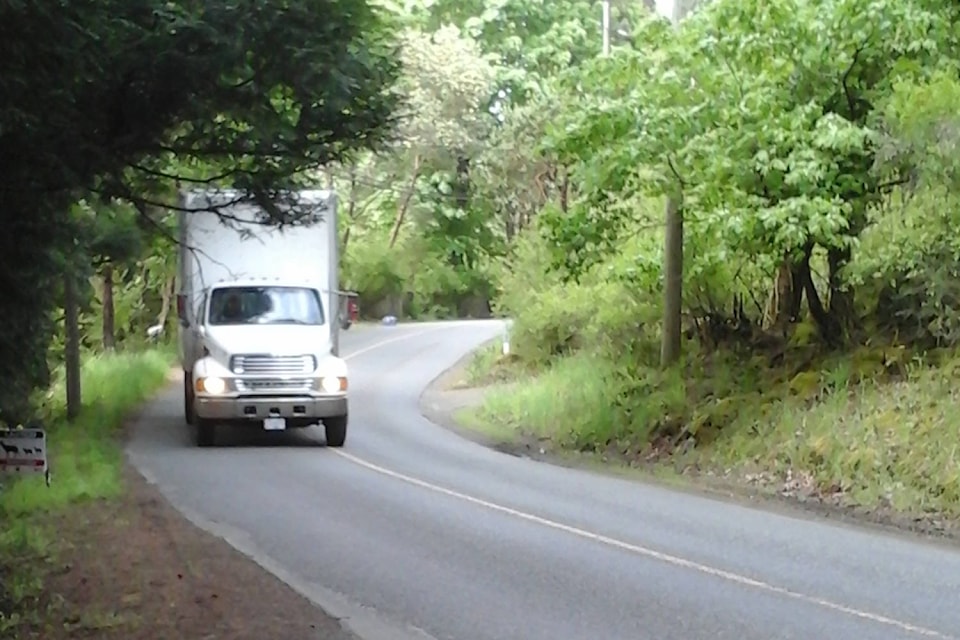Traffic originating outside of Saanich is increasingly threatening the safety of residents in rural Saanich.
That is message from a group of residents concerned about the state of roads in rural Saanich, specifically, Prospect Lake Road, Sparton Road, Goward Road, southern Old West Saanich Road and Oldfield Road within Saanich.
Members of the group calling itself Livable Roads for Rural Saanich (LRRS) appeared before council last week to raise these issues and expanded on them in a recent interview with the Saanich News.
“It boils down to at-risk users not being able to use the roads they live on,” said Guy Chester, one of the members. “These roads become rat roads to get around the commuter hours,” he said.
This phenomenon appears especially prominent on Prospect Lake Road, Sparton Road, Oldfield Road and the southern section of Old West Saanich Road, he said.
“You can see it during rush hour when it [traffic] stacks up,” said John Potter, another group member. “It’s people coming off the Trans-Canada Highway, and coming off the Island Highway that come up Prospect Lake Road and wiggle through, either going up West Saanich [Road] or through Sparton [Road], travelling north up the Peninsula, because it is just plain quicker for them.” Users have also tried to avoid Highway 17 by way of Interurban Road, Old West Saanich Road and Oldfield Road.
In short, rural Saanich faces what economists call a free-rider problem: it provides a service (roads) but cannot force out-of-area users living on the West Shore or on the Peninsula to contribute to their upkeep, while absorbing various costs, including reduced quality of life. In fact, their heavy, inappropriate use has become dangerous.
“These roads are being misused, whether it be by size, volume or speed,” said Chester. “They are completely unusable for any other type of users [such as pedestrians or cyclists] unless you want to take your lives in your own hand.”
Of particular concern are trucks with a gross vehicle weight (GVW) rating in excess of 5,500 kilograms that use all these roads as shortcuts to Central Saanich in violation of Saanich’s trucking bylaw.
So what is to be done? Pam Harrison, another group member, said the group has been working with Saanich to document the problem and develop traffic calming measures that respect the rural nature of the area. One early success includes the development of a pilot project that will place signs in the area alerting to motorists to other users.
Harrison said she does not want to see the area cut off from the rest of the region.
“Rural Saanich has many values embedded in the Rural Saanich Local Area Plan, which we offer happily to all communities,” she said. “We cover markets, vineyards, [riding], [Elk and Beaver Lakes] all sorts of things,” said Harrison. “Those are quite valuable, and we hope to foster those. It is hard to do that as a cut-through.”
Harrison said the group has also had discussions with the community association in Central Saanich, which has its own set of rural traffic issues.
“Based on what are told by Central Saanich, we are not welcomed because we are not ratepayers in Central Saanich,” said Chester. “Our issues are to be dealt with by Saanich,” added Harrison. This said, the group has had fruitful discussions with the Central Saanich Police.“It is actually because of subsequent work with Central Saanich police that we now have the truck signs up on the Central Saanich portion of Oldfield and Keating, and we have had positive dialogues with [Central Saanich],” she said. “This cooperation has been achieved by LRRS efforts.”
The group has not given much thought to taking their case to neighbouring communities, or even the Capital Regional District. Rather, it has focused on building up credibility with Saanich staff to help come up with a local solution in the absence of a regional approach, said Leo Polowich.
“We know that problem is not going to go away, said Chester. “So how are we going to mitigate it? We know the pressure is not going to go away. Langford and Colwood aren’t going to stop building permits.”
Potter agrees. “At the end of the day, we are pretty sure that the only people who can do anything about this is Saanich, so that is where we are focusing on,” he said.
But it is not hard to hear the frustrations of the group, which feels municipalities work in silos at the expense of the greater whole. “It is just one example of the ludicrous nature of having 13 municipalities,” said Chester.
